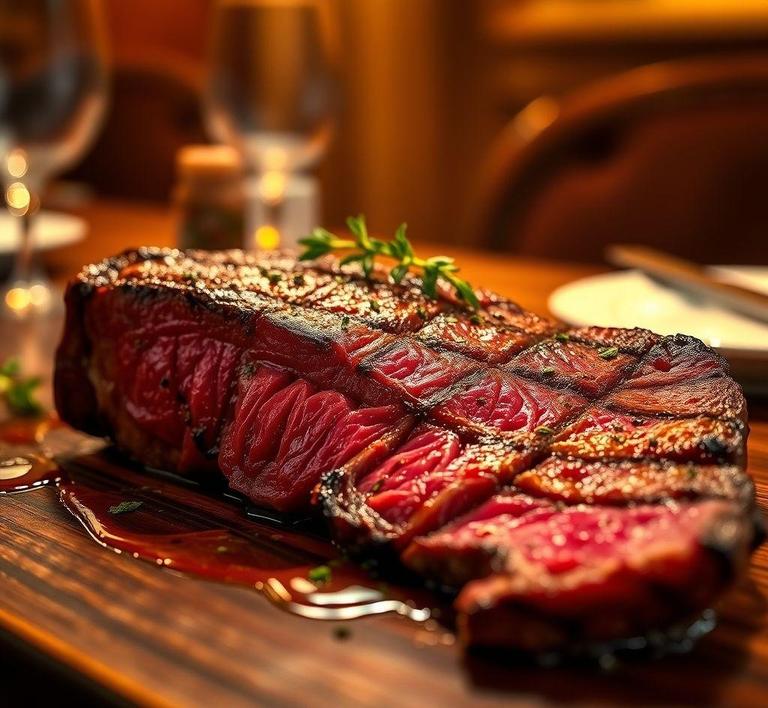If you’re someone who loves venison, you know how important it is to keep it fresh and properly stored. Sometimes, life happens, and you might find yourself with leftover venison that needs to be saved for later. The good news is, you can refreeze venison, but there are a few things to keep in mind to ensure it stays tasty and safe to eat. This guide will walk you through the best methods to refreeze venison, from thawing it properly to understanding how it affects texture and flavor. Whether you’re a hunter, a home cook, or just a venison enthusiast, this guide will help you keep your meat in top shape for future meals.
Can You Refreeze Venison?

When it comes to handling venison or any type of wild game meat, the question of whether you can refreeze it is an important one. The simple answer is yes, you can refreeze venison, but there are several caveats to keep in mind. First and foremost, the meat must have been properly thawed in the refrigerator (not at room temperature) and not left out for extended periods, as bacteria can quickly proliferate in warm conditions, especially in meats like venison that are leaner than conventional meats.
However, the more pressing concern is not just whether it’s safe to refreeze venison, but how the quality of the meat will be affected in the process. Refreezing venison can lead to a loss in texture, moisture, and flavor, especially if it is refrozen multiple times. The best practice is to only refreeze venison once, and even then, only if it has been handled properly during its initial thawing and freezing processes.
How To Refreeze Venison?
Refreezing venison should always be done with care to maintain its safety and quality. Here are the key steps to follow if you find yourself needing to refreeze venison:
-
Ensure Proper Thawing:
If you’ve previously frozen the venison, always thaw it in the refrigerator. This helps prevent the meat from entering the "danger zone" (between 40°F and 140°F), where harmful bacteria can multiply rapidly. Thawing the meat in cold water or in the microwave may be faster, but it risks introducing bacteria if the venison is left in warmer conditions for too long.
-
Inspect the Meat:
Before refreezing, check the venison for any signs of spoilage, such as an off smell or discoloration. If the meat has been thawed and has been sitting in the refrigerator for more than 2 days, it’s safer not to refreeze it.
-
Wrap the Meat Properly:
To minimize freezer burn and protect the venison’s flavor and texture, wrap it tightly in moisture-proof packaging. Use freezer paper, vacuum-seal bags, or heavy-duty plastic wrap to create a tight seal. Air exposure is the enemy when freezing meat, as it leads to freezer burn-dry patches that can ruin the taste and texture.
-
Label and Date:
Always label the venison with the date it was frozen. This is important for both safety and quality control. Even though you’re refreezing the meat, its freshness and ideal taste window are limited, so keeping track of how long it’s been stored is essential.
-
Freeze Promptly:
Once the venison has been properly wrapped and sealed, return it to the freezer as soon as possible. The faster the freezing process, the better, as this helps preserve the quality of the meat. Try to freeze the venison in smaller portions to ensure even freezing.
Quality Impact
Refreezing venison, while safe under certain conditions, does have an impact on the overall quality of the meat. The most noticeable changes come in the texture and moisture content.
-
Texture Degradation:
Venison is naturally a leaner meat compared to beef or pork, which means it already has less fat to keep it moist during cooking. When venison is frozen, the water in its cells forms ice crystals, and the freezing process disrupts the structure of the meat. Upon thawing and refreezing, more water is lost as ice crystals form and break down cell walls. This results in a drier, tougher texture, which can make the venison less enjoyable to eat.
-
Moisture Loss:
The moisture loss from freezing and refreezing is perhaps the most significant impact on quality. Wild game meat like venison doesn’t have the fat marbling that helps retain moisture, so when it’s exposed to freezing and thawing cycles, it can become dry and chewy. While you can compensate for some moisture loss by marinating or slow-cooking the venison, it’s not the same as having fresh, moist meat.
-
Flavor Deterioration:
Refreezing venison may also cause a subtle but noticeable drop in flavor. The enzymes and chemical reactions that occur in meat while it is frozen affect its taste. While this is not always immediately perceptible, repeated freezing and thawing cycles can lead to a less fresh and less vibrant flavor profile. Venison, in particular, has a distinct, rich flavor that is prized by many; this can become muted with refreezing.
-
Freezer Burn:
If the venison isn’t sealed properly, freezer burn is a real risk. This occurs when the meat is exposed to air in the freezer, causing dehydration of the outer layers. The result is a tough, dry surface that can also have an off-putting flavor. While freezer burn doesn’t make the meat unsafe to eat, it certainly diminishes its quality.
While it is indeed possible to refreeze venison, the process should be approached with care and consideration. Ensuring that the meat has been thawed correctly and that it is sealed properly before refreezing are essential steps in maintaining both safety and quality. However, even with these precautions, refreezing will generally result in some degradation of the meat’s texture, moisture, and flavor.
If you need to refreeze venison, do so only once, and try to use it as soon as possible for the best results. For the most satisfying venison experience, fresh or properly frozen meat that hasn’t been thawed and refrozen multiple times will always yield the best outcome. If you regularly hunt or stockpile venison, consider portioning the meat in smaller amounts so that you can avoid having to refreeze large quantities, which helps maintain the best possible quality.
Is It Safe To Refreeze Venison?
Refreezing venison-or any meat, for that matter-often raises concerns about both food safety and quality. The short answer is: Yes, it is generally safe to refreeze venison, but there are some crucial guidelines to follow to ensure that you don’t compromise the meat’s quality or risk foodborne illness.
When you first freeze venison, the rapid freezing process helps preserve the texture, flavor, and nutrients of the meat. However, the act of thawing and refreezing can have an impact on these aspects. Each time meat is frozen and thawed, ice crystals form within the tissue. These crystals can rupture cell walls, leading to a loss of moisture. When you refreeze venison after thawing, this moisture loss is compounded, which can result in drier, less tender meat upon the next cooking.
From a safety standpoint, if venison has been thawed properly in the refrigerator (as opposed to at room temperature), and has not been left out for too long, it can safely be refrozen. The USDA recommends that meat should not be left out at room temperature for more than 2 hours (or 1 hour if the temperature is above 90°F). If venison has been improperly thawed (e.g., left out too long), refreezing it would introduce a serious risk of bacterial growth and foodborne illness.
One critical point to remember is that the initial freezing process and the handling of the venison after its first thaw will determine whether it’s safe to refreeze. Proper storage, hygiene, and quick processing are key.
Signs That Venison Should Not Be Refrozen
It’s essential to use your senses and judgment when determining whether venison should be refrozen. Here are a few signs that indicate venison has likely been exposed to unsafe conditions or has deteriorated to the point where it should not be refrozen:
1. Unpleasant Odor
If venison has a sour, rancid, or off odor, it’s a definite sign that it’s gone bad. Meat that has started to spoil will emit an odor that is unmistakable. Even if it was previously frozen, a foul smell indicates bacterial growth and spoilage, meaning you should avoid refreezing it.
2. Discoloration Or Sliminess
Fresh venison is usually a deep, red color. Over time, however, frozen and thawed venison might turn brownish or gray. While some color change is normal after freezing, slimy textures or dark discoloration that feels sticky or tacky to the touch are signs of bacterial contamination. At this point, the meat should be discarded, as it’s no longer safe to consume.
3. Excessive Softness Or Mushiness
Thawing and refreezing venison multiple times can cause the meat’s texture to degrade, making it become mushy or overly soft. This is a sign that the cell walls have been broken down by ice crystals. If the meat is so soft that it falls apart at the touch, it has likely lost its integrity and should not be refrozen.
4. Presence Of Ice Crystals Or Frost
If there’s visible freezer burn (i.e., patches of ice crystals on the surface or a dry, leathery appearance), the venison is not in prime condition. Freezer burn doesn’t make meat unsafe, but it does affect the quality significantly, particularly in terms of texture and flavor. If the venison has been refrozen multiple times and has signs of freezer burn, it’s best to avoid refreezing it again.
Common Refreezing Mistakes
When it comes to refreezing venison, there are several common mistakes people often make. These mistakes can lead to reduced quality, texture changes, and even health risks. Let’s break them down:
1. Refreezing Without Proper Thawing
One of the most common mistakes is refreezing venison that hasn’t been thawed properly. If you’ve thawed the venison by leaving it on the countertop for hours or overnight, bacteria may have started to grow on the surface before it was put back in the freezer. Always thaw venison in the refrigerator to ensure it remains at a safe temperature, ideally below 40°F, before refreezing it.
2. Refreezing Venison Multiple Times
Repeatedly thawing and refreezing venison creates an environment where ice crystals keep forming and breaking down the meat’s structure. With each freeze-thaw cycle, the moisture content decreases, making the venison drier and less flavorful. Ideally, venison should only be thawed once and used within a reasonable time frame.
3. Not Using Airtight Packaging
Another mistake is refreezing venison without adequate packaging. If the venison was originally thawed and refrozen in a container or plastic wrap that wasn’t sealed tightly, the meat could become contaminated by air, leading to freezer burn or absorbing odors from other foods in the freezer. Always use vacuum-sealed bags or high-quality freezer wrap when refreezing.
4. Improper Temperature Control
Refreezing venison that has thawed at room temperature can be risky. To avoid this, make sure that venison stays in a refrigerator that maintains a consistent, cold temperature during the entire thawing period. It’s also crucial to check your freezer’s temperature to ensure that it stays at 0°F or below, as fluctuations in freezer temperature can lead to partial thawing, which makes refreezing unsafe.
Tips And Tricks
While refreezing venison may be safe under certain conditions, there are ways to minimize the negative effects and ensure both safety and quality:
1. Always Thaw In The Refrigerator
Never leave venison to thaw at room temperature, as this encourages bacterial growth. Plan ahead and allow the meat to thaw slowly in the fridge. This method ensures that it remains at a safe temperature for consumption, and it can be safely refrozen within 1-2 days.
2. Vacuum Seal For Quality
For the best possible outcome when refreezing venison, use a vacuum sealer to remove air from the packaging. This prevents freezer burn, reduces the exposure to moisture loss, and extends the shelf life of the meat. Even if you don’t vacuum seal, ensure the meat is tightly wrapped in heavy-duty freezer bags to protect it from air and moisture.
3. Use Smaller Portions
Refreezing larger cuts of venison can cause uneven thawing and may encourage bacteria to grow in parts of the meat that thaw more slowly. To prevent this, portion the venison into smaller servings before freezing. This makes it easier to thaw only the amount you need, reducing the need to refreeze portions multiple times.
4. Label And Date Your Meat
When refreezing venison, label each package with the date and type of cut. Keeping track of when the meat was frozen ensures that you don’t keep it in the freezer too long and helps you avoid refreezing items that may be beyond their prime.
5. Be Mindful Of Time
Ideally, refrozen venison should be cooked within 3-4 months of its first freezing. The longer meat stays in the freezer, the more it will lose quality, even if it’s safe to eat. Keep your freezer organized so you can use older items first.
Conclusion
Refreezing venison is possible, but it requires careful attention to food safety practices and an understanding of how freezing affects the meat’s quality. By ensuring that venison is properly thawed in the refrigerator, using appropriate packaging, and limiting the number of refreeze cycles, you can preserve both the safety and the flavor of the meat.
Always remember that quality should be prioritized: While refrozen venison can be safe to eat, its texture and moisture content will degrade with each freeze-thaw cycle. Be mindful of potential signs of spoilage and common mistakes, and apply proper techniques to protect your venison from both safety risks and quality loss. With the right precautions, you can safely enjoy your venison without compromising its taste or integrity.


